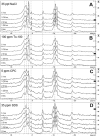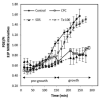Influence of surfactants and humic acids on Artemia Franciscana's embryonic phospho-metabolite profile as measured by 31P NMR
- PMID: 28285196
- PMCID: PMC5488694
- DOI: 10.1016/j.aquatox.2017.02.026
Influence of surfactants and humic acids on Artemia Franciscana's embryonic phospho-metabolite profile as measured by 31P NMR
Abstract
Surfactants, such as triton X-100 (Tx-100), cetylpyridinium chloride (CPC), and sodium dodecyl sulfate (SDS) are known to be toxic to Artemia Franciscana (Artemia) - an organism, frequently used to monitor the health of the aquatic environment. The phospho-metabolite profile of a living organism is often indicative of imbalances that may have been caused by environmental stressors, such as surfactants. This study utilizes in vivo31P NMR to monitor temporal changes in the phospho-metabolite profile of Artemia caused by Tx-100, CPC, and SDS and the ability of humic acid (HA) to mitigate the toxicity of these surfactants. It was found that, while Tx-100 does not have any effect on the phospho-metabolite profile, both CPC and SDS cause a complete retardation in growth of the phosphodiester (PDE) peak in the 31P NMR spectrum, which is indicative of the inhibited cell replication. This growth inhibition was independently verified by the decreased guanosine triphosphate (GTP) concentration in the CPC and SDS-exposed Artemia. In addition, upon introduction of HA to the CPC and SDS-exposed Artemia, an increase of PDE peak over time is indicative of HA mitigating toxicity.
Keywords: Artemia; Environmental; NMR; Surfactants; Toxicity.
Copyright © 2017 Elsevier B.V. All rights reserved.
Conflict of interest statement
Figures






Similar articles
-
Surfactant toxicity to Artemia Franciscana and the influence of humic acid and chemical composition.Environ Chem. 2016;13(3):507-516. doi: 10.1071/EN15108. Epub 2015 Nov 23. Environ Chem. 2016. PMID: 27453688 Free PMC article.
-
Binding of ionic surfactants to purified humic acid.J Colloid Interface Sci. 2004 Jul 15;275(2):360-7. doi: 10.1016/j.jcis.2004.02.061. J Colloid Interface Sci. 2004. PMID: 15178260
-
Evaluating sub-lethal stress from Roundup® exposure in Artemia franciscana using 1H NMR and GC-MS.Aquat Toxicol. 2019 Jul;212:77-87. doi: 10.1016/j.aquatox.2019.04.023. Epub 2019 May 1. Aquat Toxicol. 2019. PMID: 31077969 Free PMC article.
-
Acute toxicity and genotoxicity of five selected anionic and nonionic surfactants.Chemosphere. 2005 Mar;58(9):1249-53. doi: 10.1016/j.chemosphere.2004.10.031. Chemosphere. 2005. PMID: 15667844
-
Final report on the safety assessment of octoxynol-1, octoxynol-3, octoxynol-5, octoxynol-6, octoxynol-7, octoxynol-8, octoxynol-9, octoxynol-10, octoxynol-11, octoxynol-12, octoxynol-13, octoxynol-16, octoxynol-20, octoxynol-25, octoxynol-30, octoxynol-33, octoxynol-40, octoxynol-70, octoxynol-9 carboxylic acid, octoxynol-20 carboxylic acid, potassium octoxynol-12 phosphate, sodium octoxynol-2 ethane sulfonate, sodium octoxynol-2 sulfate, sodium octoxynol-6 sulfate, and sodium octoxynol-9 sulfate.Int J Toxicol. 2004;23 Suppl 1:59-111. doi: 10.1080/10915810490274306. Int J Toxicol. 2004. PMID: 15162838 Review.
Cited by
-
Reversible intracellular acidification and depletion of NTPs provide a potential physiological origin for centuries of dormancy in an Antarctic freshwater copepod.Sci Rep. 2023 Aug 15;13(1):13243. doi: 10.1038/s41598-023-40180-y. Sci Rep. 2023. PMID: 37582969 Free PMC article.
References
-
- Busa WB, Crowe JH, Matson G. Intracellular ph and the metabolic status of dormant and developing artemia embryos. Arch Biochem Biophys. 1982;216(2):711–718. - PubMed
-
- Certaines JD, Bovee WMMJ, Podo F. Magnetic resonance spectroscopy in biology and medicine. NMR Biomed. 1993;6(3):235–235. doi: 10.1002/nbm.1940060310. - DOI
MeSH terms
Substances
Grants and funding
LinkOut - more resources
Full Text Sources
Other Literature Sources

